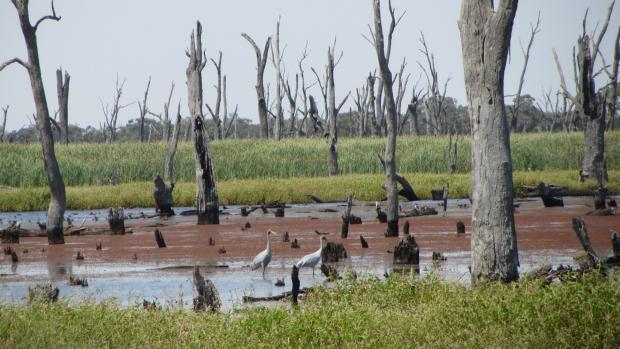Loading
Feeding the bird boom

Before European occupation, the region’s rivers would flood a lot more often than they do now. The Murray River would break its banks up to seven in every 10 years. Four of those years would result in a massive flood, up to 50km either side of the river.
The Loddon River, too, would flood regularly, especially as it hit the plains of northern Victoria.
Those floods created swamps and lakes as far as the eye could see, including 1600 wetlands in what is now the North Central Catchment Management Authority (CMA) area.
It also created a stunning array of habitat types, feeding and housing thousands of different species of fish, birds, reptiles and mammals.
Birds would migrate from across the world to make the most of the floods, and native birds would use the safety of inundated red gums and reeds and grasses to breed.
As the water drew down, waders and mudflat birds would come in, taking advantage of the access to water bugs and smaller fish.
Whole ecosystems were created on the back of fluctuating water levels and a mosaic of different habitats and systems across the region.
“However, river regulation, irrigation and climate change turned all that in its head,” North Central CMA Environmental Water Manager Louissa Rogers said.
“The Murray is managed so floods rarely occur, and historical farming and irrigation practices mean our lakes have either dried up, or have been used as water storages.
“Permanently full lakes can result in monocultures being created, and trees such as red gums and black box drowning. While all our trees love a good drink, they don’t love being inundated with water for years on end.”
Water for the environment gives communities the chance to patch together a kind of habitat quilt across the region.
“We can’t bring all these lakes back to what they once were, and we don’t want to. Irrigation farming is too important to our survival, and to our communities, but we can still achieve great things for water dependent plants and animals while not compromising our irrigation needs,” Ms Rogers said.
“Water for the environment is about rehabilitating wetlands where we can, and helping them recover from floods and droughts, as well as building resilience to help them survive the next one.
“We don’t necessarily aim to mimic what was once in a certain lake or swamp, but create a mosaic of habitat across the region to ensure different kinds of plants, water bugs, fish, birds and mammals can survive.
“While there are 1600 wetlands in our region, we only manage 14 of them with water for the environment.”
Four key parts of that mosaic – Little Lake Meran, Lake Murphy, McDonalds Swamp and Wirra-Lo Wetland Complex – will receive water for the environment in the coming weeks.
“Depending on water availability, these wetlands will also receive water for the environment in spring, to feed the large numbers of birds that were born in naturally flooded wetlands after the 2016 floods that have now started to dry out,” Ms Rogers said.
“These birds are really important because across the Murray Darling Basin we have seen a decline of waterbird numbers by 70 per cent in the past 30 years.
“Autumn watering can kick start the wetland the boom of plants and waterbugs and frogs which can start responding as soon as the weather warms up in spring.
“This is important as we use the same channels to water the wetlands as irrigators use to water their crops and pastures, and appropriately irrigation needs are a higher priority in the channel system than the environment.
“So, if our irrigators need to use the channels for irrigation when the irrigation season starts, the fact that water is already in the wetland doing its job means it doesn’t matter if we have to wait.”
Up to 500 megalitres will flow into Little Lake Meran, up to 700ML in Lake Murphy, up to 600ML in McDonald’s Swamp and up to 150ML at Wirra-Lo, a wetland complex on private property.
The flows were authorised by the Victorian Environmental Water Holder in line with its Seasonal Watering Plan 2017-18.
The VEWH Seasonal Watering Plan 2017-18 is available for download from www.vewh.vic.gov.au, with regular watering updates posted on the North Central CMA website
Water for the environment is a key part of the Victorian Government’s $222 million Water for Victoria investment from over 2016 to 2020 to improve the health of waterways and catchments.
